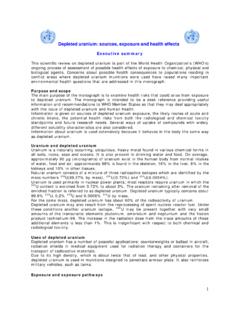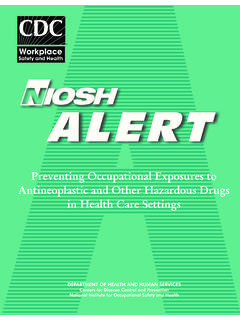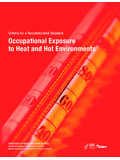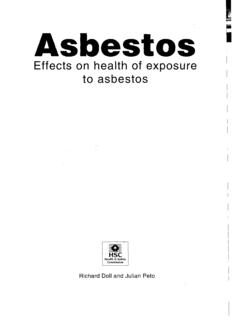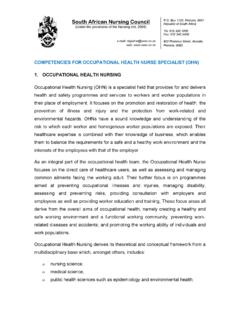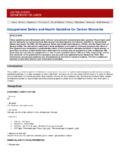Transcription of Guidelines for the Management of Occupational …
1 Guidelines for theManagement of Occupational Exposures to HBV, HCV, and HIV and Recommendations for Postexposure ProphylaxisHepatitis B Virus (HBV), Hepatitis C Virus (HCV), and Human Immunodeficiency Virus (HIV) Bloodborne viruses Can produce chronic infection Transmissible in healthcare settingsPreventing Transmissionof Bloodborne Virusesin Healthcare Settings Promote hepatitis B vaccination Treat all patients as potentially infectious Use barriers to prevent blood/body fluid contact Prevent percutaneous injuriesPreventing Percutaneous Injuries Eliminating unnecessary needle use Using devices with safety features Developing safe work practices for handling needles and other sharp devices Safely disposing of sharps and blood-contaminated materialsFactors Influencing OccupationalRisk of Bloodborne Virus Infection Prevalence of infection among patients Type of exposure and type of virus Nature and frequency of blood exposuresPrevalence of Bloodborne Virus Infection in Patients Generally higher in hospitalized patients than general population Varies with geographic area Varies with patient risk factors (injecting drug use, multiple sex partners)
2 Risk of HBV, HCV and HIV Transmission after Occupational Percutaneous exposure HBV risk varies depending on e-antigen status of source person If e-antigen positive, risk is up to 30% If e-antigen negative, risk is 1-6% HCV risk is (range of 0 - 7%) HIV risk is (range of - )Frequency of Percutaneous Injury in US Healthcare Personnel 384,325 annually (about 1000 per day) percutaneous injuries are sustained by healthcare personnel in US hospitals* The number of injuries sustained outside of hospital settings is unknown Frequency of percutaneous injury varies by occupation and healthcare setting* Panlilio, AL, et. al. Estimate of the Annual Number of Percutaneous Injuries in Healthcare Workers. 4th Decennial Conference, March 5-9, 2000 exposure Types for Blood/Body Fluid Exposures* June 1995-December 2000(n=12,678)Percutaneous10,378 (82%)Mucous membrane1817 (14%)Non-intact skin352 (3%)Bite131 (1%)Device Types for Percutaneous Injuries June 1995-December 2000 (n=10,378)Hollow-bore needle (60%)Solid sharp (32%)Suture needle (17%) Scalpel (7%)Other (8%) Glass (2%)Other/ unknown (6%)Postexposure Management Clear policies/procedures Confidentiality of exposed and source persons Management of exposures Posted in visible place Training of healthcare personnel Rapid access to clinical care postexposure prophylaxis (PEP)
3 Testing of source patients/exposed persons Injury prevention assessmentElements of Postexposure Management Wound Management exposure reporting Assessment of infection risk type and severity of exposure bloodborne infection status of source person Appropriate treatment, follow-up, and counselingPostexposure Management :Wound Care Clean wounds with soap and water Flush mucous membranes with water No evidence of benefit for: application of antiseptics or disinfectants squeezing ( milking ) puncture sites Avoid use of bleach and other agentsPostexposure Management :The exposure Report Date and time of exposure Procedure , where, how, with what device exposure , body substance involved, volume/duration of contact Information about source person and exposed personPostexposure Management : Assessment of Infection Risk Type of exposure percutaneous mucous membrane non-intact skin bites resulting in blood exposure Body substance blood bloody fluid Semen, vaginal secretions, CSF, pleural, peritoneal, pericardial, amnioticPostexposure Management : Assessment of Infection Risk Source person presence of HBsAg presence of HCV antibody presence of HIV antibodyPostexposure Management : Unknown or Untestable Source Consider information about exposure where and under what circumstances prevalence of HBV, HCV, or HIV in the population group Testing of needles and other sharp instruments NOT RECOMMENDED unknown reliability and interpretation of findings hazard of handling sharp instrumentPostexposure Management .
4 Evaluating the Source Informed consent should be obtained in accordance with state and local laws Confidentiality of the source personOccupational HBV ExposuresConcentration of HBV in Body FluidsHighModerateLow/Not DetectableBloodSemenUrineSerumVaginal FluidFecesWound exudatesSalivaSweatTearsBreast MilkElements of Postexposure Management : HBV Baseline evaluation and testing of exposed person with unknown HBV immune status Consideration of treatment when to give what to give Follow-up testing and counselingPostexposure Management : Baseline HBV Testing of Exposed* Person Test for anti-HBs if person has been vaccinated, but vaccine response is unknown Baseline testing not necessary if vaccine response is known If exposed person has been vaccinated and is a known responder to the vaccine, no PEP is necessaryUnvaccinatedPreviously vaccinatedAntibody responseunknownHBIG x 1 and initiate hepatitis Bvaccine seriesTest exposed person for anti-HBs1. If adequate, no treatment2.
5 If inadequate, HBIG x 1and vaccine boosterRecommended Postexposure Management : PEP for exposure to HBVSide Effects of Hepatitis B Vaccine Pain at injection site Mild to moderate fever Anaphylaxis in an estimated 1 in 600,000 doses given No serious adverse events detected through surveillance No risk of adverse effects to fetusEfficacy of HBV PEP*RegimenMultiple doses of HBIG alone when 1st dose initiated within 1 weekHepatitis B vaccine series aloneCombination of HBIG and vaccine seriesPrevention of HBV Infection70-75%70-75%85-95%Hepatitis B Vaccine:Long-Term Efficacy Anti-HBs titers decline to <10 mIU/mL in 30-50% of adults within 8-10 years after vaccination exposure to HBV results in anamnestic anti-HBs response that prevents clinically significant HBV infection Immune memory remains intact for at least 20 years after immunization Chronic HBV infection rarely documented among vaccine responders Booster doses currently not recommendedPostexposure Management : Follow-up HBV Testing of Exposed Person Perform follow-up anti-HBs testing in healthcare personnel who receive hepatitis B vaccine test for anti-HBs 1-2 months after last dose anti-HBs response to vaccine cannot be ascertained if HBIG received in the previous 3-4 monthsPostexposure Management :HBV Postexposure Counseling Refrain from donating blood, plasma, organs, tissue, or semen.
6 No need for: modification of sexual practices or refraining from becoming pregnant or breastfeeding modification to patient care responsibilities for exposed person If acute HBV infection, evaluate according to published recommendations Occupational HCV ExposuresOccupational Transmission of HCV Inefficiently transmitted by Occupational exposures Average incidence (range 0-7%) following percutaneous exposure from HCV-positive source Case reports of transmission from blood splash to mucous membrane Prevalence 1-2% among healthcare personnel Lower than among adults in the general population 10 times lower than for HBV infectionElements of Postexposure Management : HCV Baseline evaluation and testing Follow-up testing and counseling PEP Not recommended after exposure immunoglobulin not effective no data on use of antivirals ( , interferon), and may be effective only with established infection antivirals not FDA approved for this settingPostexposure Management :Baseline HCV Testing of Exposed Person If HCV-positive source, test exposed person for anti-HCV and ALT If source not infected, baseline testing not necessaryPostexposure Management :HCV Postexposure Counseling Refrain from donating blood, plasma, organs, tissue, or semen.
7 No need for: modification of sexual practices or refraining from becoming pregnant special precautions to prevent secondary transmission. modification to patient care responsibilities for exposed person, even if HCV infectedOccupational HIV ExposuresOccupations of US Healthcare Personnel withDocumented/Possible Occupational AIDS/HIV InfectionDocumented PossibleOccupation Transmission (No.) Transmission ( No.) Nurse 2434 Laboratory technician, clinical 1617 Physician, nonsurgical612 Health aide/attendant 115 Housekeeper/maintenance worker 213 Emergency medical technician/paramedic----12 Dental worker, including dentist----6 Laboratory technician, nonclinical3----Physician , surgical----6 Respiratory therapist 12 Embalmer/morgue technician12 Technician, dialysis13 Technician, surgical22 Technician/therapist, other than above----9 Other healthcare occupations----4 Total 57137 Details of the 57 Exposures Resulting in Occupational HIV TransmissionPercutaneous 48 Mucous membrane 5 Both 2 Unknown 2 Average Risk of HIV Infection to Healthcare Personnel by exposure Route Mucous Non-intact skin< Factors for HIV Transmission After Percutaneous exposure to HIV-Infected Blood.
8 Risk FactorAdjusted Odds ratio (95% CI)Deep injury15 ( )Visible blood on ( )Procedure involving ( )placed in artery or veinTerminal illness in source ( )Postexposure use of ( )Post exposure Prophylaxis IssuesAnimal Studies of PEP Efficacy Data have been difficult to interpret and extrapolate to humans, but provide encouraging evidence of the effectiveness of PEP Reduced PEP effectiveness if: Large dose of inocula Delay in time to PEP Shortened duration of PEP Decreased dose of PEPH uman Studies of HIV PEP Efficacy Little information on efficacy of PEP in humans Seroconversion infrequent following Occupational exposure to HIV-infected blood Study of converters vs nonconverters showed use of zidovudine (ZDV) was associated with an 81% decrease in the risk for HIV infection limitations include a small number of cases, and that cases and controls came from different cohorts(Cardo et al, NEJM 1997;337:1485-90.)Human Studies of HIV PEP:Prevention of Perinatal Transmission ZDV administered during pregnancy, labor, and delivery reduced transmission by 67% (Connor EM, et al.)
9 N Engl J Med 1994;331:1173-80.) Protective effect only partially explained by reduction in maternal viral load Protective effect observed when ZDV given only to newborn within the first 48-72 hours of life(Wade NA, et al. N Engl J Med 1998;339:1409-14.) ( Musoke P, et al. AIDS 1999;13:479-86.) (Guay LA, et al. Lancet 1999;354:795-802.)Elements of Postexposure Management : HIV Baseline evaluation and testing of exposed person Consideration of treatment when to give what to give pregnancy in exposed Follow-up testing and counselingPostexposure Management :Baseline HIV Testing of Exposed Person EIA standard test Direct virus assays not recommended p24 antigen PCR for HIV RNAI nitiation of HIV PEP Regard as an urgent medical concern If indicated, start PEP as soon as possible after exposure (hours rather than days) Interval after which PEP is no longer likely to be effective in humans is unknown initiating PEP even days or weeks after an exposure should be consideredRe-evaluation of HIV-Exposed PersonConsider re-evaluation of the exposed person within 72 hours additional information about the source person may become available if the source person has a negative HIV antibody test, stop PEPI mportant Concepts about HIV PEP Determining which and how many agents to use for PEP Professional judgement should be used based on local knowledge and experience in treating HIV Regimens should be tolerable to the exposed personRisk of Adverse EffectsRisk of TransmissionConsiderations When Using PEPPEPS ituations Where PEP is Rarely, if Ever.
10 Warranted Intact skin contact with blood and potentially infectious body fluids exposure to unknown source in populations where HIV prevalence is low Low-risk exposure to unknown sourceSituations for Which Expert Consultation for HIV PEP is Advised Resistance of the source virus to antiretroviral agents Known or suspected pregnancy in the exposed person Toxicity of the initial PEP regimenHIV PEP Considerations in Pregnant Exposed Women General principles pregnancy is not a contraindication for PEP exposed person should make informed decision about PEP Choosing regimen is more complex may exacerbate physiologic changes in pregnancy short/long-term effects on fetus/newborn unknown most data are on zidovudine some drugs contraindicated during pregnancyPostexposure Management :Follow-up HIV Testing of Exposed Person If source HIV positive, test at 6 weeks, 3 months, 6 months EIA standard test direct virus assays not recommended Extending follow-up to 12 months recommended for HCP who become infected with HCV following exposure to co-infected source optional in other situationsPostexposure Management :HIV Postexposure Counseling Side effects of PEP drugs Signs and symptoms of acute HIV infection fever rash flu-like illness Prevention of secondary transmission sexual abstinence or condom use no blood/tissue donation Transmission and PEP drug risks if breastfeedingNo work restriction indicatedRecommendations for Healthcare Facilities Establish a bloodborne pathogen Management policy Implement Management policies ( , training, hepatitis B vaccination, exposure reporting, PEP access, etc.)










